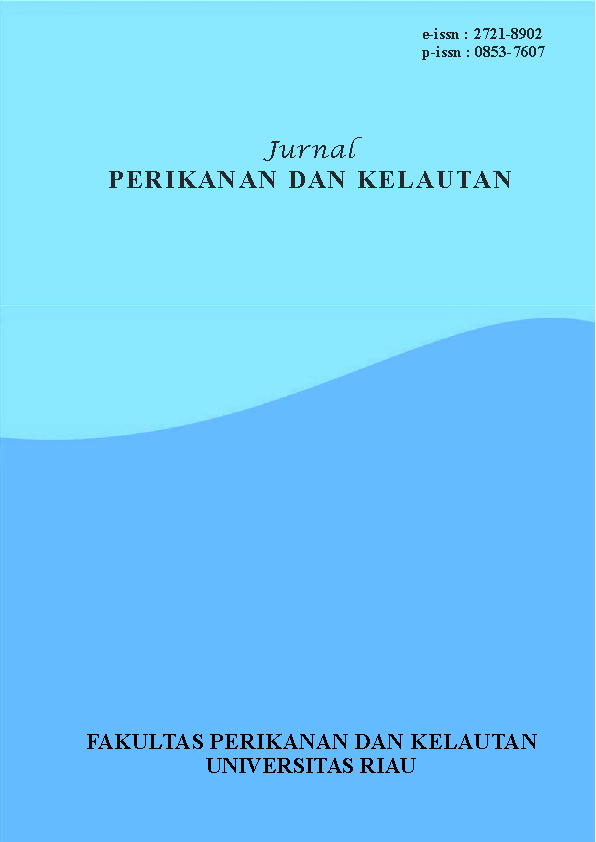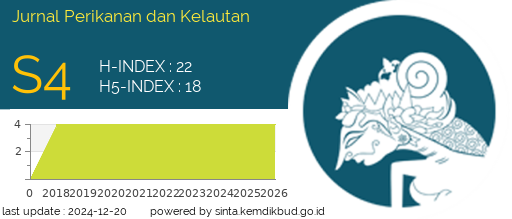The Use of Turmeric Extract (Curcuma domestica) for the Treatment and Survival of Comet Fish (Carassius auratus auratus) Infected with Aeromonas hydrophila Bacteria
DOI:
https://doi.org/10.31258/jpk.30.1.136-143Keywords:
Aeromonas hydrophila, Aquaculture, DiseasesAbstract
Comet fish (Carassius auratus auratus) is one type of freshwater ornamental fish that is highly demanded by the ornamental fish hobbyist community because it has a variety of colors and attractive physical forms. However, comet fish cultivation has decreased due to disease attacks that lead to death caused by Aeromonas hydrophila bacteria. Therefore, farmers generally use chemical drugs such as antibiotics to treat diseases in comet fish, yet for antibiotics, and it is necessary to research herbal medicines that contain antibacterial content, such as turmeric (Curcuma domestica). This research aims to determine the effect of immersion time using turmeric extract solution for treatment and survival rate of comet fish seeds infected with A.hydrophila bacteria. This is experimental research with a Completely Randomized Design (CRD) consisting of four treatments and three replicates, namely treatment A (control), B (50 minutes immersion), C (60 minutes immersion), and D (70 minutes immersion). The results showed that using turmeric extract affected treating comet fish seeds infected with A.hydrophila bacteria. As for the survival rate, the results of analysis of variance (ANOVA) showed that the use of turmeric extract had no significant effect, with the percentage value of the survival rate of comet fish seeds of treatment A (63.30%), B (90.00%), C (80.00%), and D (86.60%).
Downloads
References
Damayanti, S.M., Kristin, E.P., Fakhry, M., Kurniawan, A., & Anjani, T.P. (2024). Keganasan Aeromonas hydrophila Setelah Pasase 4 Kali Pada Ikan Lele (Clarias sp). Amreta Meena, 1(1): 5–9.
Effendi, M. (2019). Penentuan Kadar Senyawa Flavonoid Ekstrak Etanol Daun Kunyit (Curcuma domestica Val) secara Spektrofotometri Uv-Vis. Herbal Medicine Journal, 2(2): 16–20.
Fernando, R., Yanto, H., & Farida, F. (2019). Pengaruh Penambahan Tepung Wortel (Daucus carota) pada Pakan Buatan terhadap Peningkatan Kecerahan Warna Ikan Cupang (Betta splendens Regan). Borneo Akuatik, 1(2): 84–94.
Gunawan, I., & Suraya, U. (2019). Pengaruh Pemberian Pakan Tambahan Tepung Kiapu (Pistia stratiotes) Dicampur dengan Pakan Komersil terhadap Pertumbuhan Benih Ikan Lele Dumbo (Clarias gariepinus). Jurnal Ilmu Hewani Tropika, 8(1): 23–30.
Maisyaroh, L.A., Susilowati, T., Haditomo, A.H.C., Fajar, B., & Yuniarti, T. (2018). Penggunaan Ekstrak Kulit Buah Manggis (Garcinia mangostana) Sebagai Antibakteri untuk Mengobati Infeksi Aeromonas hydrophila pada Ikan Nila (Oreochromis niloticus). Jurnal Sains Akukultur Tropis, 2(2): 36–43.
Prakoso, A.V., Kusmini, I.I., Kristantanto, H.A., & Subagjo, J. (2018). Respoms dan Pola Pertumbuhan Benih Ikan Baung (Hemibagrus Nemurus) dari Tiga Generasi di Pelihara pada Wadah Budidaya yang Berbeda.” Jurnal Riset Akuakultur, 13(1): 201–211.
Pratama, I., Talaha, R., Rijal, M.A., & Susylowati, D. (2022). Respon Pertumbuhan dan Daya Tahan Tubuh Benih Ikan Mas Rajadanu (Cyprinus carpio L) yang Diberi Probiotik terhadap Infeksi Aeromonas hydrophila. Sainteks, 19(1): 69.
Rivai, H., Misfadhila, S., & Sari, L.K. (2019). Analisis Kualitatif dan Kuantitatif Kandungan Kimia dari Ekstrak Heksan, Aseton, Etanol dan Air dari Rimpang Kunyit (Curcuma domestica Val). Universitas Andalas Padang. 1–16.
Saputra, I., & Indaryanto, F.R. (2018). Identifikasi Bakteri Aeromonas hydrophila pada Komoditas Ikan yang Dilalulintaskan Menuju Pulau Sumatera Melalui Pelabuhan Penyeberangan Merak-Banten. Jurnal Perikanan dan Kelautan, 8(2): 155–162.
Simalango, R., & Sinaga, A.S. (2018). Diagnosa Penyakit Ikan Hias Air Tawar dengan Teorema Bayes. Jurnal dan Penelitian Teknik Informatika, 3(1): 43–50.
Suprihatin, T., Rahayu, S., Rifa’i, M., & Widyarti, S. (2020). Senyawa pada Serbuk Rimpang Kunyit (Curcuma longa L) yang Berpotensi Sebagai Antioksidan. Buletin Anatomi dan Fisiologi, 5(1): 35–42.
Utomo, A.S., Prayitno, S.B., & Sarjito, S. (2015). Penambahan Serbuk Daun Binahong (Anredera cardivolia) pada Pakan terhadap Respon Imun, Kelulushidupan dan Status Kesehatan Udang Windu (Penaeus Monodon) yang Diinfeksi Vibrio Harveyi. Journal of Aquaculture Management and Technology, 4(3): 61–68.
Wihardi, Y., Yusanti, I.A., & Haris, R.B.K. (2014). Feminisasi pada Ikan Mas (Cyprinus carpio) dengan Perendaman Ekstrak Daun-Tangkai Buah Terung Cepoka (Solanum torvum) pada Lama Waktu Perendaman Berbeda. Jurnal Ilmu-Ilmu Perikanan dan Budidaya Perairan, 9(1): 23–28.
Wulan, W. (2022). Identifikasi Bakteri Patogen Aeromonas sp. pada Ikan Nila (Oreochromis niloticus) di Desa Matungkas, Kecamatan Dimembe, Kabupaten Minahasa Utara. Budidaya Perairan, 10(2): 109–200
Yuhana, M., Normalina, I., & Sukenda, S. (2008). Pemanfaatan Ekstrak Bawang Putih (Allium sativum) untuk Pencegahan dan Pengobatan Ikan Patin (Pangasionodon hypophthalmus) yang Diinfeksi Aeromonas hydrophila. Jurnal Akuakultur Indonesia, 7(1): 95-107








